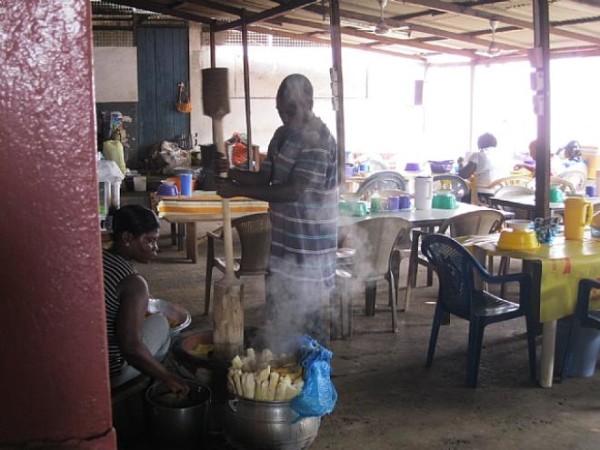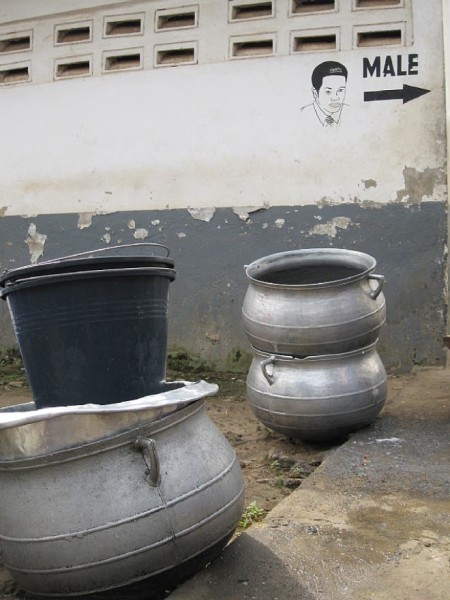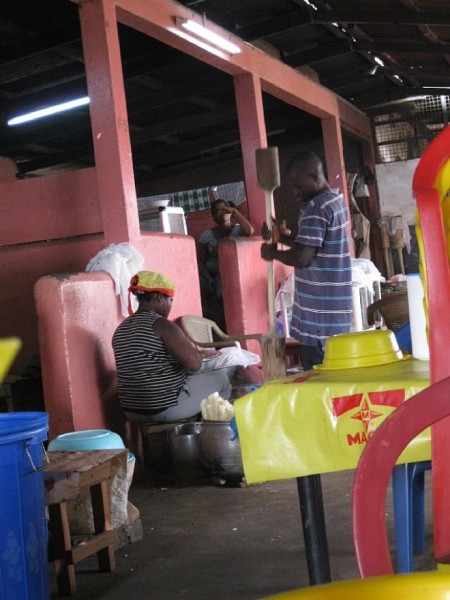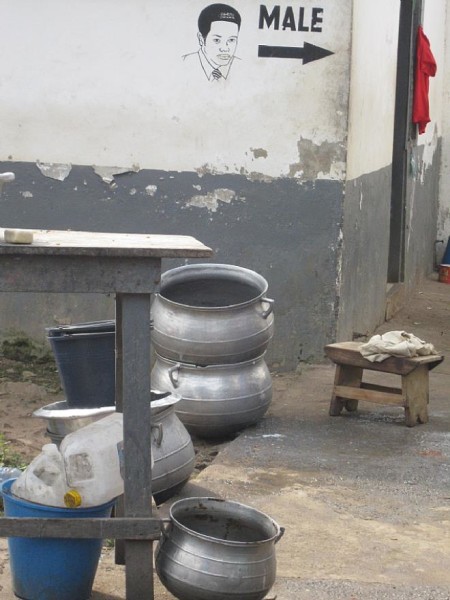Special Reports
Behind Legon’s Bush Canteen
Report by Manasseh Azure Awuni, November 2011

Maggot in the Soup
Patrick Dugle, a graduate student, says the Bush Canteen was his favourite eatery in the University of Ghana ten years ago when he pursued his first degree. And he still prefers the Bush Canteen to any other eatery in the University.
“Here at the Bush Canteen there is variety so you’re assured of whatever food you like,” he explains over a plate of plain rice and stew. “The food sold here is also cheap and affordable when compared to other canteens in the entire university,” he adds.
Patrick is, however, worried about the sanitation of the area. “Sanitation here is a big problem. It needs serious attention,” he says.
Poring over meal of banku with viscous groundnut soup and fish, Andrew Muniru Nantogmah, says he recently abandoned a plate of banku with groundnut soup and chicken he had ordered and paid for. “I saw a fat maggot in the soup,” he explains. But he has not stopped patronising Bush Canteen. He only switched on to a different food vendor. Andrew, however, believes sanitation in the canteen has reached a level that deserves “serious attention” from authorities of the market and the university.
“Apart from the maggot I saw in the soup,” Andrew says, “I had the opportunity of passing behind the main arena. That is where they cook the food, and what I saw was an eyesore. If there’s one improvement I will like to see at the Bush Canteen, then it is the sanitation problem. It’s serious”
Andrew’s and Patrick’s concerns represent the major opinion shared by students, workers and authorities of the Bush Canteen, the most popular eatery in the University of Ghana, Legon.
The name Bush Canteen
At the topmost corner of the second gate of the Bush Canteen is a grammatically-handicapped inscription: “University Worker’s Canteen.” The inscription notwithstanding, not many people know the real name of this market. They call here Bush Canteen or “Bush K” for short. The name has outlived its relevance. Mr. Akoto Akwasi Bani, chairman of the Bush Canteen Traders Association, says when the canteen was built, the university had not expanded to its present state. One had to walk through the bush to get to the canteen. “Here was actually in the bush. So the students called it Bush Canteen.”
Aba Sampson, a student of the School of Communication Studies, says Bush Canteen is “the heartbeat of Legon.” Apart from food, Bush Canteen has a lot more to offer – a vibrant market.
The rectangular market is about half the size of a football pitch, but the canteen occupies only one-third of that space. The rest is occupied by traders and artisans offering all manner of services. There are five barbering shops and eight hairdressing salons, as well as, many provision shops. Many students sew their clothes here. There are also books and stationery shops, photocopy and printing services and a music shop.
The most popular cobbler in the university is found in this market.
The market can also boast of five drinking spots, which are empty by day but very much alive under the cover of darkness. Despite the variety of services offered here, entire market is called Bush Canteen. And but for the high prison-like walls that cordon off the area, the Bush Canteen would have been visible to commuters at the Legon Bus Stop on the Madina-Accra road.
The canteen itself is made up of a cluster of diverse food vendors. One is sure to find any meal of one’s choice, both “local and continental.” The sheds are in two long rows, facing each other. Facing the east of the Bush Canteen one sees writings advertising some of popular vendors of the canteen: Makafui Yesu Special Kenkey, God is Good Special Beans and Plantain, C. Amanda’s Fast Food and Babson’s Fast Food and Catering Services etc.
The opposite direction is occupied by sellers of mainly banku and fufu. The Cost Cutter, Delasi’s Kitchen and Sarah’s kitchen are among the boldly written signs fighting the black soot to retain their conspicuousness and original colour.
The atmosphere at Bush Canteen is characterised by the rhythmic sound of heavy wooden pestles hitting fufu. The task is usually carried out by stocky young men, with bodies dotted with beads of perspiration.
The middle, which is about the size of a basketball court, is where people eat. It can sit about 120 people at a time, but at peak hours it is a common sight to find people holding food and waiting for someone to vacate their seat before they can eat. The long rows of dining tables are distinguished from one vendor to the other by the colour of their coverings.
Turning their heads skillfully to scoop soup, patrons of the canteen must also keep waving a hand over the food to ward off the relentless houseflies that invade the area. Below the corrugated iron aluminum sheets which serve as shelter, hung ceiling fans. But their effect is never felt.

Quality but unhygienic food
“Our main problem here is the heat,” says Ms. Sarah Addo, owner of Sarah’s Kitchen, the most popular joint in the Bush Canteen. Sarah’s Kitchen serves banku and fufu. The 40-year old vendor, who looks like someone in her early 30s, has been in the Bush Canteen for the past eight years. She says heat is the main reason some people in the university do not patronise Bush Canteen. “Can you imagine a student or somebody taking his lover to the canteen only be met with this heat?” she asks me.
Louisa Nii Quaye, 39-year old owner of Daavi’s Special Beans and Bambara agrees with Sarah. Louisa has been in this business for 20 years and says despite the profitability, heat is what might force her to quit the job. “The kitchens are too small and so some people, as you can see, warm their soups and do part of the cooking here,” she says.
To the vendors, the heat might be the main cause of their discomfort and worry because it sends potential customers away from the eatery. But the customers and other observers have a different concern.
The Director of Health Services at the University of Ghana believes sanitation at the Bush Canteen needs serious attention. Dr. Christian Kofi Amenuveve says gastro intestinal disorders such as cholera, diarrhoea are among the top four sicknesses students of the University of Ghana are diagnosed with.
Dr. Amenuveve, who would not give a definitive answer about whether he patronises the Bush Canteen or not, says the place is a strategic component of the university and must be given more attention.
“Some of the foods they serve are of better quality in terms of taste and nutritional value than even some well-established restaurants in the city. It is no wonder many people prefer Bush Canteen to other canteens in the university. The only problem is the sanitation,” he told me in his office at the Univeristy Hospital.
Food Prepared Beside Public Toilet
Most of the foods served at Bush Canteen are prepared in the open, behind the main selling and eating area because some vendors do not have kitchens. Sarah admits that even those vendors with kitchens still boil their yam and cassava in the open before taking it to the kitchen to pound. Apart from boiling cassava and yam, gigantic pots of soup are prepared in the open, sometimes without any covering.
In that little cooking space is where all the vendors wash their plates and cooking utensils. A perpetually nauseating stench from an open and usually choked drain as well as an air force of houseflies hold sway in this area. Here, cooking utensils are sometimes left unwashed for hours. As if this is not enough, there is a public toilet and urinal less than five metres away from where the pots of soup and other food items are left to cook without covering.
The toilet facility is much neater than the usual public toilets, but its state does not pass for an ideal toilet facility considering its nearness to the canteen. It is a water closet facility but all the handles of the flushing systems are broken. The only sink in the toilet has water flowing but without soap. The otherwise white sink is gradually becoming brownish due to neglect. Inside the toilet stands a mixture of urinal and faecal stench. It is poorly ventilated and house flies can be seen in the day flying merrily in and out of the facility. From here where do they go?
Food Vendors Worried
“If I were not working here there’s no way I would ever buy food here,” says Sarah, who is very worried about the worsening situation of sanitation at the Bush Canteen. “I’m not insulting the intelligence of those who eat here but I’m just being Frank. I do well to keep my kitchen and everything neat because my family and I eat what I prepare here. But I will not lie to you that there are not sanitation challenges here.”
Sarah’s biggest headache is the open drain. The chairman of the market is, however, very defensive of the sanitation situation. Mr. Akoto sees nothing wrong with closeness of the toilet to the kitchen if only it is kept neat. He however agrees the open drain is too small, hence the choking. “We have presented a proposal to the Estates Department but they say there’s no money for that project now,” he says.
Louisa agrees there is a sanitation problem in the area but says it is more of an individual problem than a general problem. “Some of us do well to keep our utensils and sheds neat. The flies are also another problem but we are doing our best to keep the place neat,” she says.
The Chairman of the Bush Canteen sellers association says his outfit keeps educating the vendors to observe sanitary measures. Mr. Akoto says he personally inspects and ensures that the vendors adhere to sanitation standards. Dr. Amenuveve, however, says the supervision is supposed to be carried out by trained environmental and sanitation officers, but the vendors say they don’t remember the last time such an official visited the Canteen.

Handling Food with Bare hands
Another sanitation standard which is compromised at Bush Canteen is the handling of food. Some of the vendors handle food with the bare hands they use to receive money from buyers, exposing consumers to health risks. A study conducted by two Ghanaian scientists has revealed that 98.6 per cent of the Ghana Cedi notes are contaminated with bacteria.
According to the study, which was conducted between November 2008 and February 2009, some of the cedi notes were contaminated with pathogenic micro-organisms which could spread diseases. The study was conducted by Mr. Patrick Feglo and Mr. Michael Nkansah of the Department of Clinical Microbiology of the School of Medical Sciences and the Department of Medical Laboratory Technology of the Faculty of Allied Health Sciences, respectively.
However, foods such as kenkey, fish, and fufu are served with bare hands even though these vendors also handle money.

Bush ‘K’ is Strategic
The Bush Canteen is situated near the main halls and lecture theatres of the university, making it more accessible than its main rival, the Night Market. Sarah Addo believes the only option is to improve the sanitation of the canteen because Bush Canteen is very strategic and cannot be allowed to rot away. Sarah says her family depends on her business.
“I have also employed 14 people and they earn their livelihood here,” she says. “Where will all these people go if this business should be allowed to collapse because of poor sanitation?”
Louisa Niiquaye says she inherited her business from her mother some 20 years ago. Though she will not disclose how much profit she makes, she says the beans business has been the source of livelihood to her family.
“My mother started it and now she’s opened a provision shop at home from the proceeds. Three of my siblings have also completed their tertiary education using funds from this business,” she reveals.
Though Andrew is aware of the sanitation problem at Bush Canteen, he cannot do without it. “For some of us, Bush Canteen is what our pockets can afford. If the problem of sanitation is not addressed, then some of us are at risk.”
NOTE: This report led to the refurbishment of the Legon Bush Canteen and a significant improvement of the sanitation situation there.

-

 Random Thoughts6 months ago
Random Thoughts6 months agoA Dutch Passport or a Ghanaian PhD?
-

 Foreign News9 years ago
Foreign News9 years agoEvery Animal Meat Is Not Beef! See All Their Names
-

 Manasseh's Folder7 months ago
Manasseh's Folder7 months agoManasseh’s Praise and Criticism of Akufo-Addo’s Action on the SML Scandal
-

 Manasseh's Folder5 months ago
Manasseh's Folder5 months agoIs Napo Arrogant? And Does It Matter?
-

 Guest Writers8 years ago
Guest Writers8 years agoProf. Kwaku Asare writes: Nana Akufo-Addo has no law degree but…
-

 Manasseh's Blog Posts4 months ago
Manasseh's Blog Posts4 months agoWho Started Free SHS?
-

 Manasseh's Folder8 years ago
Manasseh's Folder8 years agoEXCLUSIVE PHOTOS: Manasseh Azure Awuni marries “Serwaa”
-

 Guest Writers6 years ago
Guest Writers6 years agoIs “Engagement” a Legal Marriage?